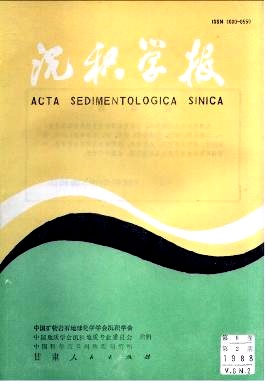LACUSTRINE DEPOSITS IN LATE PERMIAN OF EERDUOSI BASIN
- Received Date: 1986-08-29
- Publish Date: 1988-06-10
Abstract: Late Permian lacustrine deposits consists predominantly of interbedded grayish-brown sandstones and conglomerates and red to gray mudstones in the Eerduosi Basin. This series mentioned above is 500-600 m thick and five main facies associations are recognized: subaqueous fan, alluvail plain on lake bank, lacustrine delta, marginal lacustrine, and offshore lacustrine facies association. Of these the characteristics and distributions are derived from this study: Subaqueous fan deposits are of three subfacies types differ from each other in fabric, commonly formed at southwest margin of the studied area. The inner-fan deposits are characterized by developing of channel. Only a few structure of tractive current are in the mid-fan and outer-fan, Common character is that, sorting and stratification are generally not well developed. Alluvail plain deposits consist of interbedded grayish-brown sandstones, pebbly sandstones and red mudstones, commonly formed at north of studied area. The sandstones and pebbly sandstones are characterized by moderate to poor sorting, developing of platy cross-bedding and trough cross-bedding, fining-upward in the bedding set thickness and grain size. Fossils are not abundant in this facies but calc-nodules are abundant. Lacustrine delta deposits, formed at north and east, have developing character of Gilbert-type, contain abundant trough cross-bedding and gently inclined cross-bedding laminations analogous to foresets in the Gilbert deltas. Marginal-lacustrine deposits are divided into four subfacies: (1) lake bay subfacies that be dominanted by red to green mudstones, containing algae and faunal fragment; (2) shoreline subfacies which be dominanted by poorly sorted pebbly sandstones or well sorted sandstones, containing horizontal and cross-bedding, muddy ripping and vertebrates fragment; (3) nearshore lacustrine subfacies that be dominanted by red to grey mudstones, containing plants, ostracodes, bivalve, conchostracas and trace fossils; and (4) nearshore bar association subfacias which composed of elongate lenticular sandstones bodies having convex-downward bases or flat bases and convex-upward tops, and may containing crossbeds that dip to one or more sides of the lens. Offshore lacustrine deposits formed at south of the studied area. They consist mainly of gray to brown-gray horizontal or lumpy bedding mudstones, and contain conchostraca and bivalve.
| Citation: | Yang Changgui, Yuan Zhixiang. LACUSTRINE DEPOSITS IN LATE PERMIAN OF EERDUOSI BASIN[J]. Acta Sedimentologica Sinica, 1988, 6(2): 123-131. |






 DownLoad:
DownLoad: